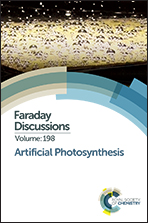Towards artificial methanogenesis: biosynthesis of the [Fe]-hydrogenase cofactor and characterization of the semi-synthetic hydrogenase
Abstract
The greenhouse gas and energy carrier methane is produced on Earth mainly by methanogenic archaea. In the hydrogenotrophic methanogenic pathway the reduction of one CO2 to one methane molecule requires four molecules of H2 containing eight electrons. Four of the electrons from two H2 are supplied for reduction of an electron carrier F420, which is catalyzed by F420-reducing [NiFe]-hydrogenase under nickel-sufficient conditions. The same reaction is catalysed under nickel-limiting conditions by [Fe]-hydrogenase coupled with a reaction catalyzed by F420-dependent methylene tetrahydromethanopterin dehydrogenase. [Fe]-hydrogenase contains an iron-guanylylpyridinol (FeGP) cofactor for H2 activation at the active site. FeII of FeGP is coordinated to a pyridinol-nitrogen, an acyl-carbon, two CO and a cysteine-thiolate. We report here on comparative genomic analyses of biosynthetic genes of the FeGP cofactor, which are primarily located in a hmd-co-occurring (hcg) gene cluster. One of the gene products is HcgB which transfers the guanosine monophosphate (GMP) moiety from guanosine triphosphate (GTP) to a pyridinol precursor. Crystal structure analysis of HcgB from Methanococcus maripaludis and its complex with 6-carboxymethyl-3,5-dimethyl-4-hydroxy-2-pyridinol confirmed the physiological guanylyltransferase reaction. Furthermore, we tested the properties of semi-synthetic [Fe]-hydrogenases using the [Fe]-hydrogenase apoenzyme from several methanogenic archaea and a mimic of the FeGP cofactor. On the basis of the enzymatic reactions involved in the methanogenic pathway, we came up with an idea how the methanogenic pathway could be simplified to develop an artificial methanogenesis system.
- This article is part of the themed collection: Artificial Photosynthesis

 Please wait while we load your content...
Please wait while we load your content...